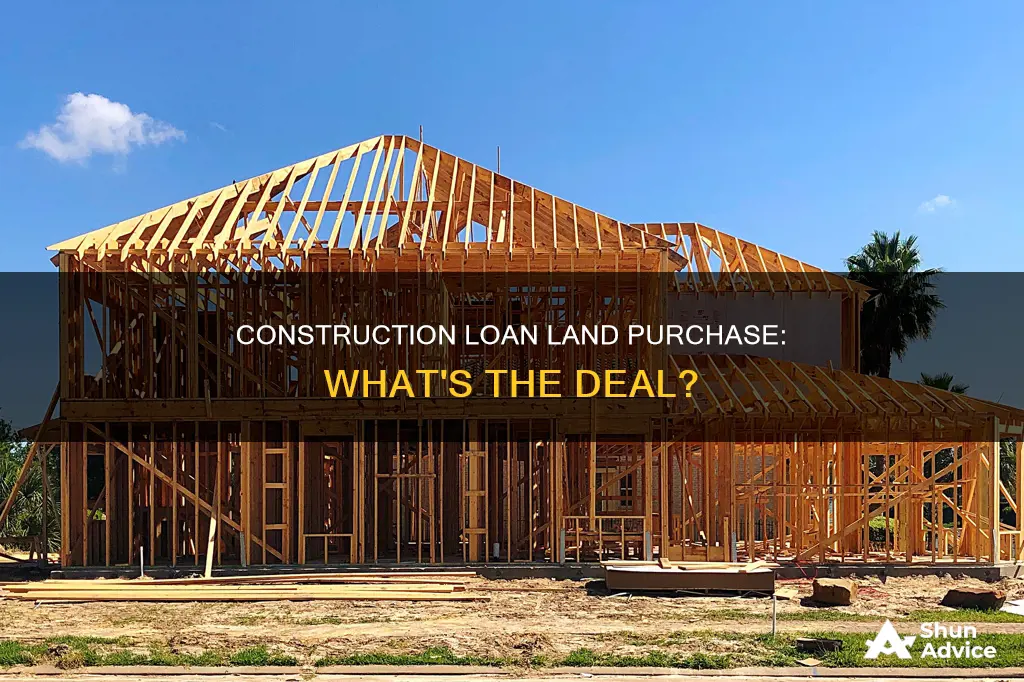
Construction loans are a type of financing option for those looking to build a new property or renovate an existing one. They can be used to cover the cost of land acquisition, site preparation, labour, and material expenses. In general, a construction loan will cover the cost of the land and the construction. However, it is important to note that construction loans do not include design costs such as architect or interior designer fees. The loan amount is determined by the lender based on the construction budget, the land's value, and other factors influencing the project's profitability. Construction loans are typically short-term loans, with the initial term lasting a year or less, and involve multiple draws or disbursements of funds at various stages of the project.
| Characteristics | Values |
|---|---|
| What does it cover? | Costs of building a home, including contractor fees, labour, permits, and the land or property lot itself. |
| How is the money released? | Funds are released in intervals or draws, directly to the contractor. |
| How to qualify for a loan? | Lenders will want to see your plans, projected budget, schedule, income, credit score, and financial history. |
| How to repay the loan? | Construction loans are short-term loans, lasting a year or less, or up to 18 months. Once construction is complete, the loan is converted into a mortgage or paid off in full. |
| What are the benefits? | More design flexibility, ability to build where you want, and increased landholdings. |
| What are the drawbacks? | Higher interest rates, closing costs, and the risk of a higher mortgage interest rate if rates increase during construction. |
What You'll Learn

Construction loans can be used to buy land
USDA construction loans, for example, are a type of government-backed mortgage program that offers simplified financing. With a USDA construction loan, you can buy land, build a new home, and finance the finished home over 30 years with a single-close construction loan. However, it's important to note that these loans may have more requirements and can be challenging to qualify for.
When applying for a construction loan, you will need to provide the lender with various documents, such as the construction plan, budget, and timeline. The lender will also consider the land's value and the total projected cost of the property to determine the loan amount. It's important to remember that construction loans do not cover design costs, so you will need to cover the cost of hiring a professional architect or interior designer separately.
Construction loans are typically released in intervals, with the lender checking the progress of the construction before releasing additional funds. This helps to keep the project moving along according to schedule and ensures that funds are used appropriately. After construction is complete, you will need to convert the construction loan into a traditional permanent mortgage or pay off the loan in full. This involves submitting additional documents and going through the underwriting process again.
Overall, construction loans can be a great option for those looking to buy land and build a home, as they provide the necessary financial support to complete the project. However, it's important to carefully consider the requirements and qualifications before taking out a construction loan.
Title Loans: Are They Legal in New York State?
You may want to see also

Construction loans can be converted to mortgages
Construction loans are short-term loans that can be used to build a home. They can be used to fund the purchase of land and the construction of a residential home on that land. They are different from mortgages in that they are distributed in stages as the construction progresses, rather than in a lump sum. Borrowers are also only required to make interest payments during the construction phase.
The conversion of construction-to-permanent financing involves granting a long-term mortgage to a borrower to replace the interim construction financing used to fund the construction of a new residence. The borrower must hold the title to the lot and all construction work must be completed and paid for before the mortgage loan is delivered. The lender must also retain a certificate of occupancy or an equivalent form from the applicable government authority.
It is important to note that construction loans have higher interest rates than mortgages. Therefore, by converting a construction loan into a mortgage, borrowers may be able to secure a lower interest rate for their loan. This can be a significant benefit, especially if interest rates have fallen during the construction period.
Sallie Mae Loan App: Hard Inquiry or Not?
You may want to see also

Construction loans can be used to renovate existing buildings
Construction loans are typically used to finance the building of a new home from scratch. However, they can also be used to finance renovations or remodelling projects for existing buildings.
While it is not their primary purpose, construction loans can be used to fund substantial renovation projects for current homeowners. Renovation loans, on the other hand, are specifically intended to finance home improvements or repairs to increase a home's value. Construction loans are typically short-term loans with higher interest rates and large fees, designed to cover the costs of land, plans, permits, labour, materials, and closing costs. Renovation loans, such as the FHA 203(k) loan, can be more suitable than construction loans as they allow you to include the purchase price of the property and the cost of renovations within a single loan.
Construction loans are typically used by individuals who want to build a home from scratch. They are short-term loans with steep fees and interest rates. The funds are not disbursed in a lump sum but are instead paid in instalments to the contractor throughout the project. This process is known as a progressive drawdown or a construction-only loan. With a construction-only loan, you will need to apply for a second loan, resulting in two sets of closing costs.
Renovation loans, such as the FHA 203(k) loan, the Fannie Mae HomeStyle Renovation loan, and the Freddie Mac CHOICERenovation loan, are intended for those who need to finance home renovations or repairs to increase the value of their home. These loans can also be used to purchase a lower-priced home that requires work. Renovation loans are typically only granted for major upgrades rather than smaller projects. They can provide a convenient way to cover both the home price and renovation costs in one loan, potentially resulting in lower interest rates.
It is important to consider the benefits and drawbacks of construction loans for renovations. Construction loans offer more flexible terms than traditional mortgages, allowing borrowers to pay only the interest during construction before switching to a more permanent mortgage. They also provide increased borrowing power based on the home's after-repair value. However, construction loans may have higher interest rates than renovation loans, and it may be challenging to secure one compared to a conventional mortgage.
Stop Loan App Calls: Regain Peace of Mind
You may want to see also

Construction loans are short-term loans
Construction loans usually have a term of about a year or, less frequently, 18 months. During this time, the borrower must finish the construction project. To obtain a construction loan, borrowers must meet the lender's borrowing standards and provide building plans, an estimated construction timeline, and a proposed budget for approval. The lender will release funds at various phases of the project, usually directly to the contractor. These draws tend to happen when major milestones are completed, such as when the foundation is laid or the framing of the house begins.
Construction loans can be converted into mortgages after the construction is complete. During the construction loan phase, borrowers are only responsible for interest payments on the money drawn. Once the loan is converted into a mortgage, borrowers start making payments that cover interest and the principal. Construction loans are considered riskier than traditional mortgages and usually have higher interest rates and more stringent criteria.
Construction loans can cover the costs of buying land, drafting plans, taking out permits, and paying for labour and materials. They also include closing costs. If the borrower already owns the land, they may be able to use it as collateral for the loan. Construction loans provide borrowers with the flexibility to create a home that meets their specific needs and wants without the restrictions imposed by homeowners' associations.
Title Loans: Who Are the Buyers?
You may want to see also

Construction loans require a down payment
Construction loans are a great way to build your dream home from the ground up. They offer design flexibility, allowing you to create a tailor-made home that suits your needs and desires. You can also build on your own land, giving you the freedom to choose your ideal location, whether it's close to town or surrounded by nature.
However, it's important to note that construction loans are more complex than conventional mortgages and carry a higher risk for lenders. As a result, interest rates tend to be slightly higher, and down payments can also increase. The down payment for a construction loan is typically due when you close the loan, and the amount can vary depending on the type of construction loan you choose.
Conventional construction loans, including single-close and two-close loans, usually require a down payment between 5% and 20%. To avoid paying mortgage insurance premiums, you'll need to put down 20%. FHA construction loans, on the other hand, offer a low down payment option, with a minimum requirement of 3.5%. VA construction loans provide similar advantages for qualifying veterans.
Some lenders may also allow you to use your land as a down payment, depending on its equity and value. It's worth noting that not all banks offer construction loans for building on your own land. Therefore, it's essential to get pre-approved or pre-qualified before finalizing your plans.
When applying for a construction loan, lenders will typically assess your architectural plans, budget, choice of contractors, materials, and personal finances to ensure they are comfortable with the risk. They will also usually pay your contractors in intervals, known as draws, based on the milestones achieved in the construction project.
Overall, while construction loans do require a down payment, the amount and timing can vary depending on the loan type and lender. It's important to do your research and understand the requirements before applying for a construction loan to build your dream home.
Understanding Private Loan Disbursement: Who Receives the Funds?
You may want to see also
Frequently asked questions
Yes, you can get a construction loan if you already own the land. In this case, the loan will help you pay for the costs of building from the ground up, with the benefit of land equity.
A construction loan can be used to cover the cost of land acquisition and the construction itself. This includes site preparation, labour, materials, permits and contractor fees. However, it does not include design costs such as architect or interior designer fees.
After approval, you won't receive the money directly. Instead, your lender will pay your contractor in intervals. The money is released in draws or disbursements to keep the project moving according to schedule.







